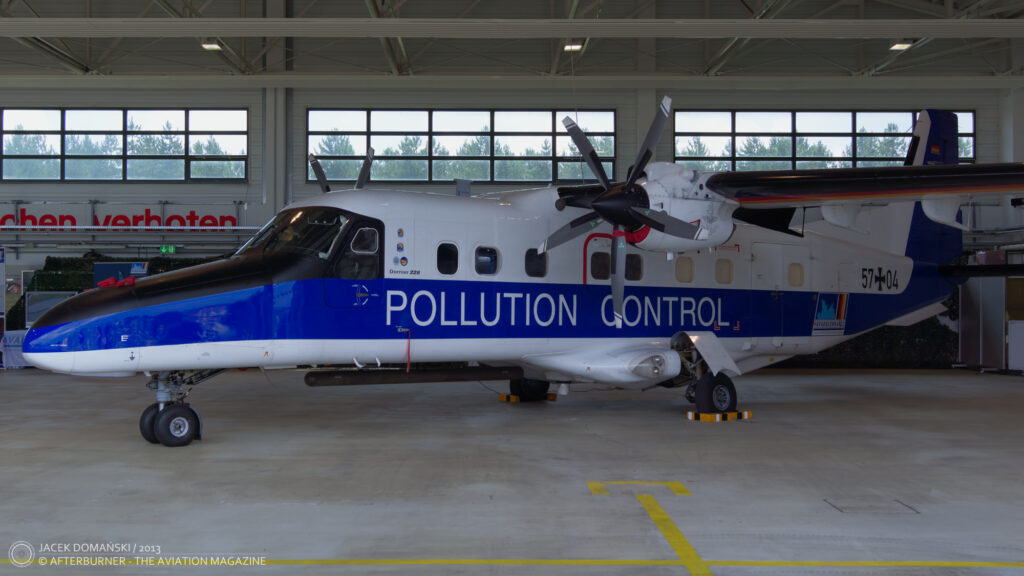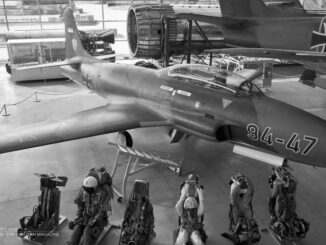 Dornier Do 228-212LM (c/n 8214, 57+04 of the German Naval Aviation / Marineflieger), static display at spotter day organized on the eve of the 100th Anniversary of the German Naval Aviation, Nordholz air base, August 2013.
Dornier Do 228-212LM (c/n 8214, 57+04 of the German Naval Aviation / Marineflieger), static display at spotter day organized on the eve of the 100th Anniversary of the German Naval Aviation, Nordholz air base, August 2013.
The story of German twin-engine, turboprop STOL utility aircraft began in the late 1970s. At that time, the Dornier company launched development of a new technology aeroplane wing, within a programme financed by the German government.
The new wing – designated Tragflügel neuer Technologie (TNT) / English: Aerofoil new technology – was initially tested on Do 28D-2 Skyservant aircraft, equipped with two PT6A-110 turboprop engines. In the next stage, the Dornier company changed the engines to Garret AiResearch (later Honeywell) TPE-331 and such redeveloped aircraft was then designated Do 128.
Eventually, the Dornier company built a completely new fuselage for the TNT wing. The prototypes were made in two variants, for 15 and 19 passengers, and were designated E-1 and E-2, respectively. They were disclosed to general public during the 1980 edition of Internationale Luft- und Raumfahrtausstellung (ILA) in Berlin, under the brand name Dornier Do 228-100 and Do 228-200.
Nevertheless, both prototypes performed their maiden flights only almost one year after the aforementioned public premiere – on 28th March and 9th May 1981. Later that year, the German type certification was granted for the new aircraft and the first Do 228s were delivered to their customers, German local airlines.
The new airliner was pretty well received in the market. It was finally acquired by approximately thirty local airlines all over the world, more than twenty military operators, as well as several government agencies and law enforcement services.
In 1996, the Dornier aviation division was acquired by Fairchild Aircraft. Within two years from the merge, production of the Do 228 was ceased and the company focused on bigger aeroplanes, such as Do 328.
Approximately 250 examples of the Do 228 were produced by Dornier, with further 125 examples made under licence in India, by Hindustan Aeronautics Limited. There were nine main versions of the aircraft, with Do 228-212 being the last modification implemented in 1989. The upgraded aeroplane featured more powerful engines, reinforced landing gear, modernized avionics and maximum take-off weight increased up to 6,400 kg.
Nevertheless, in 2002, the RUAG holding took over the Do 228 manufacturing rights and re-launched its production. The aircraft was significantly modernised and designated Do 228NG (New Generation). In 2010 the Do 228NG received its type certification from the European Aviation Safety Agency.
That new, redeveloped variant was manufactured by RUAG – with varying degree of success – until 2020. Eventually in 2021, the rights to manufacture the Do 228NG were acquired by General Atomics from the United States.
***
At the beginning of 1990s, the German Federal Ministry of Transport (Bundesverkehrsministerium) ordered two special maritime surveillance aircraft, equipped with oil pollution monitoring sensors.
They were ordered at Dornier and based on the Do 228-212 airframe that was converted into so-called LM variant (the abbreviation stands for Luftüberwachung Meeresverschmutzung / English: Air surveillance sea pollution), equipped with extensive and advanced monitoring equipment. It included Side-Looking-Airborne-Radar for locating surface pollution, infra-red and UV scanners, as well as microwave radiometer for measuring thickness and amount of pollutants, video and photo equipment to provide additional evidence, as well as laser fluorine sensor to identify the kind of contamination.
Such an extensive equipment was necessary due to German legal regulations that required precise documentation and evidence for any sea pollution. And that made the both naval Do 228 unique in the world, as in most countries photo and video evidence, confirmed by the crew, would be enough.
The special aircraft were delivered in 1991 (57+01 for Marinefliegergeschwader 5 in Kiel) and 1997 (57+04 for Marinefliegergeschwader 3 ´Graf Zeppelin´ in Nordholz), together with two other Do 228 for liaison purposes.
In 2010, Germany retired the older aeroplane, then replacing it with the Do 228NG (57+05) of the same assignation and having similar equipment. In 2015, the aircraft 57+04 was modernized at the RUAG company plant, being upgraded to the NG standard that included glass cockpit, new avionics and five-blade propellers.
In 2020, the Federal Office of Bundeswehr Equipment, Information Technology and In-Service Support signed an agreement with Aerodata AG / OPTIMARE Systems GmbH, covering the further modernisation of the both Do 228LM aircraft of the German Naval Aviation.
The aeroplane 57+04, featured within our Photo of the Week series, was the first one being upgraded at Aerodata and was already delivered back to Marineflieger in March of 2023. Delivery of the second retrofitted aircraft, the 57+05, is expected to proceed later this year.
The German Navy Do 228LMs are currently being operated by Marinefliegergeschwader 3 ´Graf Zeppelin´ in Nordholz.



